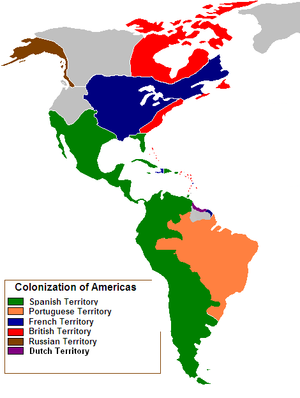American Revolution/Chapter 1: The English Colonies in 1750/Lesson 3
Key Terms
[edit | edit source]Physical Geography
[edit | edit source]Political Geography
[edit | edit source]
Cultural Geography
[edit | edit source]Initial Colonization of North America
[edit | edit source]Three surges of colonization brought peoples to the North American continent. Beginning more than 15,000 years ago during an Ice Age, the first natives crossed from Siberia into Alaska via the Bering Land Bridge. (Scholars use genetic analysis of native residents in Alaska and Canada as proof of this migration pattern. The DNA of Native Americans, especially the northern peoples of Alaska and Canada, closely resembles that of native Siberians.) Pursuing herds, the colonizers pushed east and south. As the continent warmed, the ice retreated and movement became easier.

A second wave of migration occurred approximately 12,000 years ago. At its narrowest, the Bering Sea was only three miles wide. Peoples who speak Athabascan today descend from a group of migrants who left Siberia after the land bridge disappeared using small canoes. These peoples pushed east and south along the Rocky Mountains into the deserts of the American Southwest. Today they comprise the Navajo and Apache nations.
A third surge of colonization began about 5,000 years ago. These migrants, the ancestors of the Inuit and Aleut, were skilled boat builders and specialized in hunting sea mammals, like whales and seals. The Aleut settled the Aleutian Islands of Alaska while the Inuit settled along the Arctic's edge and slowly moved eastward through Canada and into Greenland.[1]
Native American Culture
[edit | edit source]Initially, Paleo-Indians lived by hunting and gathering in small bands. Most of the archeological sites show temporary encampments near perennial springs, waterholes, and river crossings. These peoples used a basic spear with a sharp, flaked-stone point bound tightly to a wooden shaft for hunting. As they expanded into more temperate climates, the natives established more permanent settlements that incorporated hunting/gathering with agriculture for sustenance. Hunting evolved into seasonal excursions while gathering focused on the preservation of resources native to a particular place. These natives also practiced basic land management techniques like setting fire to wooded areas to control brush and enhance deer habitat as well as weeding out inedible plants.[2]
The Native Americans exhibited many characteristics of European society. They had structured gender and familial relations, distinct language (albeit unwritten), religious and spiritual beliefs, construction, agriculture, and in some places, advanced mathematics and astronomy. Despite this, the Europeans believed the natives to be primitive because their religious beliefs, focusing on animism, discouraged metal tools and domesticated animals. Almost immediately, the Europeans pushed to convert the natives to Christianity.
Because Christianity alienated spirit from nature, the Europeans felt justified spiritually to harvest and utilize the land. In fact, they believed it to be their godly duty to subjugate the environment and bring the newly discovered territories into cultivation just as it was their duty to Christianize the natives. Alongside their religion, the Europeans also brought their technology, economic systems, and familial hierarchies/relations to the New World.
